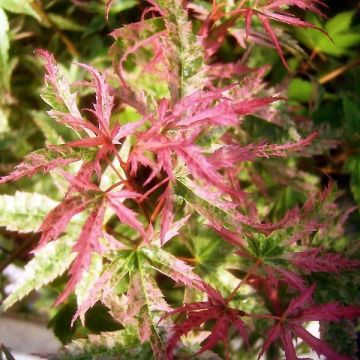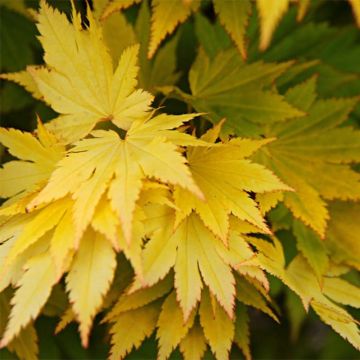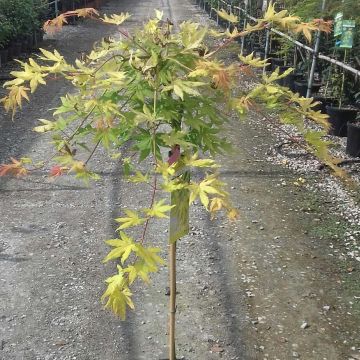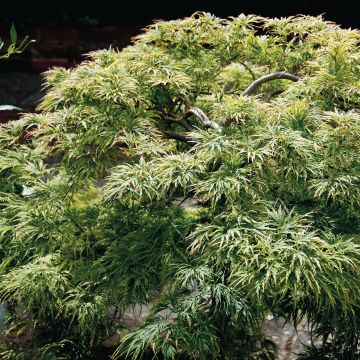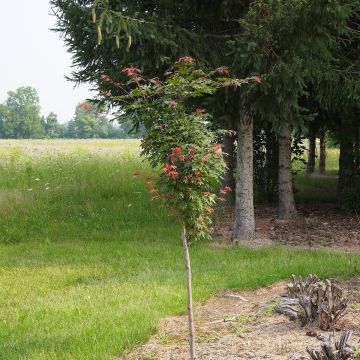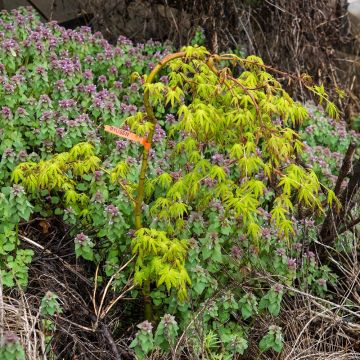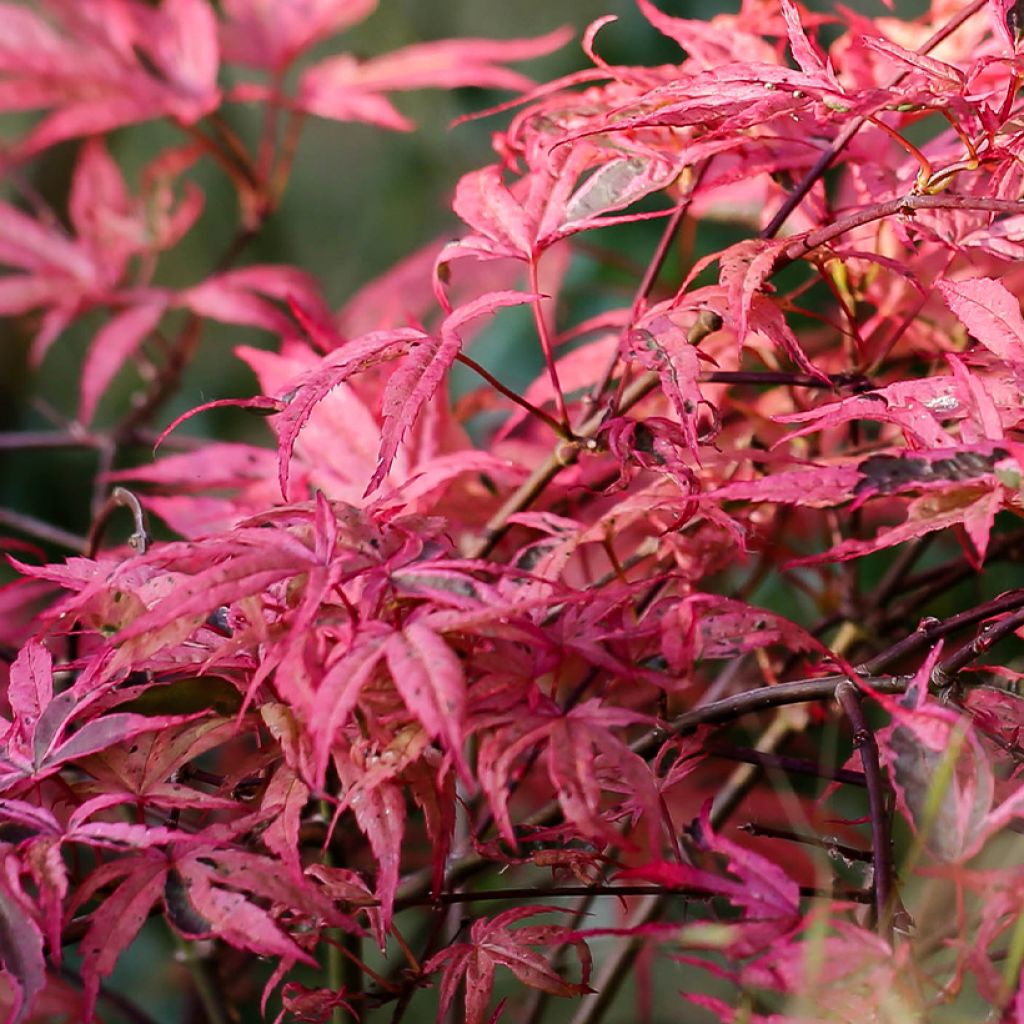

Acer palmatum Pink Passion - Japanese Maple
Acer palmatum Pink Passion - Japanese Maple
Acer palmatum Pink Passion
Japanese Maple, Palmate Maple
This item cannot be shipped to the selected country
Delivery charge from €5.90
Delivery to Corse prohibited
More information
Schedule delivery date,
and select date in basket
This plant carries a 24 months recovery warranty
More information
We guarantee the quality of our plants for a full growing cycle, and will replace at our expense any plant that fails to recover under normal climatic and planting conditions.
From €5.90 for pickup delivery and €6.90 for home delivery
Express home delivery from €8.90.
Delivery to Corse prohibited: UE law prohibits the import of this plant from mainland France to Corse as part of the fight against Xylella fastidiosa. Please accept our sincere apologies.
More information
Does this plant fit my garden?
Set up your Plantfit profile →
Description
The Acer palmatum 'Pink Passion', also known as Acer palmatum var. roseomarginatum is a superb variety of Japanese maple with remarkably colourful variegated foliage. When planted in a sunny location, it is purple-pink with bright pink edges in spring, turns purple-red in summer, and then dark red to orange-red in autumn. Its leaves are puckered and unusual. The bush has a spreading habit and its branches bend with age, which adds to its charm. Give it a prominent position, visible from the house, or in a pot in indirect sunlight.
Originally from eastern China, Korea, and Japan, the Acer palmatum is the origin of a multitude of horticultural varieties that compete in beauty. The Japanese palmate maple belongs, like all maples, to the Aceraceae family. It is relatively hardy but only tolerates limestone-free soils.
The 'Pink Passion' cultivar develops a spreading to rounded habit over time. Eventually, it reaches a height and spread of 3m (10ft) in all directions. This small tree has a brown to reddish bark and develops magnificent deciduous leaves, with palmate shape, divided into 5 to 7 ovate and acuminate lobes, puckered and rather unusual. They are a pretty dark pink with fuchsia edges in full sun. They can also be white, green, or brown when the tree is placed in partial shade. This foliage turns orange-red in autumn. The leaves are opposite on the branches, 10cm (4in) long. Inconspicuous flowering occurs in May-June. The purple flowers, grouped in small clusters, sometimes produce winged fruits, called samaras, measuring 3cm (1in) in length.
The Acer palmatum 'Pink Passion' grows in lightly sunny or partial shade positions, sheltered from cold and dry winds. It is sensitive to high temperatures and drought. It thrives in slightly acidic, moist, fertile, loose, and well-drained soil. With a very beautiful appearance, it is compact and suitable for small gardens, for ornamenting terraces, as well as for large shaded rockeries. Enhance its varied colours with low-growing perennials such as Heucheras with coloured foliage, for example, black Ophiopogons, or small hostas. In flower beds, add acid-loving plants such as wild camellias, heathers, and small Japanese azaleas. Plant it as a specimen or mix several varieties of Japanese maples to create a lively and vibrant range of colours.
Report an error about the product description
Plant habit
Flowering
Foliage
Botanical data
Acer
palmatum
Pink Passion
Aceraceae
Japanese Maple, Palmate Maple
Cultivar or hybrid
Other Japanese Maples
Planting and care
The Acer palmatum 'Pink Passion' is planted in spring or autumn in a preferably acidic, cool but not damp, deep, loose and well-drained soil, in a semi-shaded position sheltered from cold and dry winds. The Verticillium disease, which affects many Japanese maples, will develop less easily in substrates that dry out a little between two waterings. Add a significant amount of organic matter every 3 years to ensure a good humus content in the soil. Mulch the soil if necessary and spray the foliage on hot evenings. Winter pruning is limited to balancing the branches. Treat against scale insects and Verticillium.
Planting period
Intended location
Care
This item has not been reviewed yet - be the first to leave a review about it.
Haven't found what you were looking for?
Hardiness is the lowest winter temperature a plant can endure without suffering serious damage or even dying. However, hardiness is affected by location (a sheltered area, such as a patio), protection (winter cover) and soil type (hardiness is improved by well-drained soil).

Photo Sharing Terms & Conditions
In order to encourage gardeners to interact and share their experiences, Promesse de fleurs offers various media enabling content to be uploaded onto its Site - in particular via the ‘Photo sharing’ module.
The User agrees to refrain from:
- Posting any content that is illegal, prejudicial, insulting, racist, inciteful to hatred, revisionist, contrary to public decency, that infringes on privacy or on the privacy rights of third parties, in particular the publicity rights of persons and goods, intellectual property rights, or the right to privacy.
- Submitting content on behalf of a third party;
- Impersonate the identity of a third party and/or publish any personal information about a third party;
In general, the User undertakes to refrain from any unethical behaviour.
All Content (in particular text, comments, files, images, photos, videos, creative works, etc.), which may be subject to property or intellectual property rights, image or other private rights, shall remain the property of the User, subject to the limited rights granted by the terms of the licence granted by Promesse de fleurs as stated below. Users are at liberty to publish or not to publish such Content on the Site, notably via the ‘Photo Sharing’ facility, and accept that this Content shall be made public and freely accessible, notably on the Internet.
Users further acknowledge, undertake to have ,and guarantee that they hold all necessary rights and permissions to publish such material on the Site, in particular with regard to the legislation in force pertaining to any privacy, property, intellectual property, image, or contractual rights, or rights of any other nature. By publishing such Content on the Site, Users acknowledge accepting full liability as publishers of the Content within the meaning of the law, and grant Promesse de fleurs, free of charge, an inclusive, worldwide licence for the said Content for the entire duration of its publication, including all reproduction, representation, up/downloading, displaying, performing, transmission, and storage rights.
Users also grant permission for their name to be linked to the Content and accept that this link may not always be made available.
By engaging in posting material, Users consent to their Content becoming automatically accessible on the Internet, in particular on other sites and/or blogs and/or web pages of the Promesse de fleurs site, including in particular social pages and the Promesse de fleurs catalogue.
Users may secure the removal of entrusted content free of charge by issuing a simple request via our contact form.
The flowering period indicated on our website applies to countries and regions located in USDA zone 8 (France, the United Kingdom, Ireland, the Netherlands, etc.)
It will vary according to where you live:
- In zones 9 to 10 (Italy, Spain, Greece, etc.), flowering will occur about 2 to 4 weeks earlier.
- In zones 6 to 7 (Germany, Poland, Slovenia, and lower mountainous regions), flowering will be delayed by 2 to 3 weeks.
- In zone 5 (Central Europe, Scandinavia), blooming will be delayed by 3 to 5 weeks.
In temperate climates, pruning of spring-flowering shrubs (forsythia, spireas, etc.) should be done just after flowering.
Pruning of summer-flowering shrubs (Indian Lilac, Perovskia, etc.) can be done in winter or spring.
In cold regions as well as with frost-sensitive plants, avoid pruning too early when severe frosts may still occur.
The planting period indicated on our website applies to countries and regions located in USDA zone 8 (France, United Kingdom, Ireland, Netherlands).
It will vary according to where you live:
- In Mediterranean zones (Marseille, Madrid, Milan, etc.), autumn and winter are the best planting periods.
- In continental zones (Strasbourg, Munich, Vienna, etc.), delay planting by 2 to 3 weeks in spring and bring it forward by 2 to 4 weeks in autumn.
- In mountainous regions (the Alps, Pyrenees, Carpathians, etc.), it is best to plant in late spring (May-June) or late summer (August-September).
The harvesting period indicated on our website applies to countries and regions in USDA zone 8 (France, England, Ireland, the Netherlands).
In colder areas (Scandinavia, Poland, Austria...) fruit and vegetable harvests are likely to be delayed by 3-4 weeks.
In warmer areas (Italy, Spain, Greece, etc.), harvesting will probably take place earlier, depending on weather conditions.
The sowing periods indicated on our website apply to countries and regions within USDA Zone 8 (France, UK, Ireland, Netherlands).
In colder areas (Scandinavia, Poland, Austria...), delay any outdoor sowing by 3-4 weeks, or sow under glass.
In warmer climes (Italy, Spain, Greece, etc.), bring outdoor sowing forward by a few weeks.


































